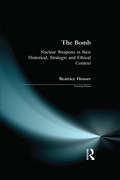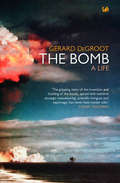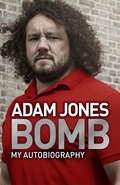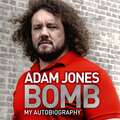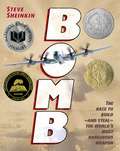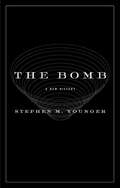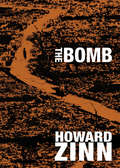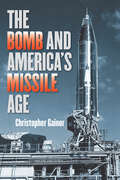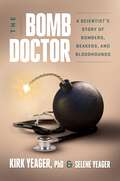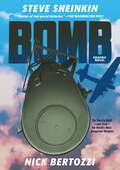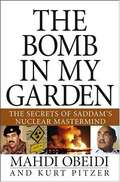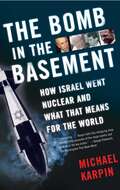- Table View
- List View
The Bomb: Nuclear Weapons in their Historical, Strategic and Ethical Context (Turning Points)
by D.B.G. HeuserThis tightly argued and profoundly thought provoking book tackles a huge subject: the coming of the nuclear age with bombing of Hiroshima and Nagasaki in August 1945, and the ways in which it has changed our lives since. Dr Heuser sets these events in their historical context and tackles key issues about the effect of nuclear weapons on modern attitudes to conflict, and on the ethics of warfare. Ducking nothing, she demystifies the subject, seeing `the bomb' not as something unique and paralysing, but as an integral part of the strategic and moral context of our time. For a wide multidisciplinary and general readership.
The Bomb: A Life
by Gerard DeGrootBefore the Bomb, there were simply 'bombs', lower case. But it was the twentieth century, one hundred years of almost incredible scientific progress, that saw the birth of the Bomb, the human race's most powerful and most destructive discovery. In this magisterial and enthralling account, Gerard DeGroot gives us the life story of the Bomb, from its birth in the turn-of-the-century physics labs of Europe to a childhood in the New Mexico desert of the 1940s, from adolescence and early adulthood in Nagasaki and Bikini, Australia and Siberia to unsettling maturity in test sites and missile silos all over the globe. By turns horrific, awe-inspiring and blackly comic, The Bomb is never less than compelling.
The Bomb: A Life
by Gerard J. DeGrootIn The Bomb: A Life, Gerard DeGroot tells the story of this once unimaginable weapon that--at least since 8:16 a.m. on August 6, 1945--has haunted our dreams and threatened our existence. His book portrays the Bomb's short but significant existence in all its scope, providing us with a portrait of the times and the people--from Oppenheimer to Sakharov, Stalin to Reagan--whose legacy still shapes our world.
Bomb: My Autobiography
by Adam JonesIn rugby, there are the Flash Harrys and the Glory Boys: the fly-halves who run, kick and dazzle; the scrum-halves who nip and dart; the wingers who step and glide. These are the players who get the crowd on their feet, who set stadiums abuzz. But they only get to do these things because other, less glorified figures do all of the donkey work. Adam Jones is one such figure. And for a decade he was one of the world's best. On many occasions when George North or Shane Williams were careering under the posts to score a try, and the crowd was engulfed in rapturous joy, Adam Jones would be hauling himself up from the turf, spitting blood and mud, and massaging his aching neck. He hadn't scored the try; but more often than not it was his graft and strength which had made it. This is the story of 'Bomb': the self-effacing manual labourer from the Swansea Valley who traded laying paving slabs for running out in some of the world's most imposing sporting citadels. He rose to the pinnacle of his sport, winning virtually everything there was to be won: Grand Slams, Six Nations Championships, Lions tours, Pro12 titles. In a nation of rugby heroes, Adam Jones has become a legend. Only six Welshmen can say they've won three Grand Slams. He is one of them: not just as a bit-part player, but as the beating heart of the most successful squad in Welsh rugby history. His was one of the first names on the team sheet. He was - literally and metaphorically - the cornerstone of this Welsh side. In his autobiography, Jones reveals exactly what goes on in the murky depths of the front row: the tricks, the techniques, the physical and psychological warfare; and the mental fortitude it takes to endure in one of the hardest positions, in one of the world's toughest contact sports.
Bomb: My Autobiography
by Adam JonesIn rugby, there are the Flash Harrys and the Glory Boys: the fly-halves who run, kick and dazzle; the scrum-halves who nip and dart; the wingers who step and glide. These are the players who get the crowd on their feet, who set stadiums abuzz. But they only get to do these things because other, less glorified figures do all of the donkey work. Adam Jones is one such figure. And for a decade he was one of the world's best. On many occasions when George North or Shane Williams were careering under the posts to score a try, and the crowd was engulfed in rapturous joy, Adam Jones would be hauling himself up from the turf, spitting blood and mud, and massaging his aching neck. He hadn't scored the try; but more often than not it was his graft and strength which had made it. This is the story of 'Bomb': the self-effacing manual labourer from the Swansea Valley who traded laying paving slabs for running out in some of the world's most imposing sporting citadels. He rose to the pinnacle of his sport, winning virtually everything there was to be won: Grand Slams, Six Nations Championships, Lions tours, Pro12 titles. In a nation of rugby heroes, Adam Jones has become a legend. Only six Welshmen can say they've won three Grand Slams. He is one of them: not just as a bit-part player, but as the beating heart of the most successful squad in Welsh rugby history. His was one of the first names on the team sheet. He was - literally and metaphorically - the cornerstone of this Welsh side. In his autobiography, Jones reveals exactly what goes on in the murky depths of the front row: the tricks, the techniques, the physical and psychological warfare; and the mental fortitude it takes to endure in one of the hardest positions, in one of the world's toughest contact sports.
Bomb: My Autobiography
by Adam JonesIn rugby, there are the Flash Harrys and the Glory Boys: the fly-halves who run, kick and dazzle; the scrum-halves who nip and dart; the wingers who step and glide. These are the players who get the crowd on their feet, who set stadiums abuzz. But they only get to do these things because other, less glorified figures do all of the donkey work. Adam Jones is one such figure. And for a decade he was one of the world's best. On many occasions when George North or Shane Williams were careering under the posts to score a try, and the crowd was engulfed in rapturous joy, Adam Jones would be hauling himself up from the turf, spitting blood and mud, and massaging his aching neck. He hadn't scored the try; but more often than not it was his graft and strength which had made it. This is the story of 'Bomb': the self-effacing manual labourer from the Swansea Valley who traded laying paving slabs for running out in some of the world's most imposing sporting citadels. He rose to the pinnacle of his sport, winning virtually everything there was to be won: Grand Slams, Six Nations Championships, Lions tours, Pro12 titles. In a nation of rugby heroes, Adam Jones has become a legend. Only six Welshmen can say they've won three Grand Slams. He is one of them: not just as a bit-part player, but as the beating heart of the most successful squad in Welsh rugby history. His was one of the first names on the team sheet. He was - literally and metaphorically - the cornerstone of this Welsh side. In his autobiography, Jones reveals exactly what goes on in the murky depths of the front row: the tricks, the techniques, the physical and psychological warfare; and the mental fortitude it takes to endure in one of the hardest positions, in one of the world's toughest contact sports.(P)2015 Headline Digital
The Bomb: Presidents, Generals, and the Secret History of Nuclear War
by Fred KaplanFrom the author the classic The Wizards of Armageddon and Pulitzer Prize finalist comes the definitive history of American policy on nuclear war—and Presidents&’ actions in nuclear crises—from Truman to Trump.Fred Kaplan, hailed by The New York Times as &“a rare combination of defense intellectual and pugnacious reporter,&” takes us into the White House Situation Room, the Joint Chiefs of Staff&’s &“Tank&” in the Pentagon, and the vast chambers of Strategic Command to bring us the untold stories—based on exclusive interviews and previously classified documents—of how America&’s presidents and generals have thought about, threatened, broached, and just barely avoided nuclear war from the dawn of the atomic age until today. Kaplan&’s historical research and deep reporting will stand as the permanent record of politics. Discussing theories that have dominated nightmare scenarios from Hiroshima and Nagasaki, Kaplan presents the unthinkable in terms of mass destruction and demonstrates how the nuclear war reality will not go away, regardless of the dire consequences.
Bomb: The Race to Build -- and Steal -- the World's Most Dangerous Weapon
by Steve SheinkinIn December of 1938, a chemist in a German laboratory made a shocking discovery: When placed next to radioactive material, a Uranium atom split in two. That simple discovery launched a scientific race that spanned 3 continents. In Great Britain and the United States, Soviet spies worked their way into the scientific community; in Norway, a commando force slipped behind enemy lines to attack German heavy-water manufacturing; and deep in the desert, one brilliant group of scientists was hidden away at a remote site at Los Alamos. This is the story of the plotting, the risk-taking, the deceit, and genius that created the world's most formidable weapon. This is the story of the atomic bomb.<P><P> Bomb is a 2012 National Book Awards finalist for Young People's Literature.<P> Bomb is a 2012 Washington Post Best Kids Books of the Year title.<P> Bomb is a 2013 Newbery Honor book.<P> Bomb is the 2013 Robert Sibert Information Book Medal winner.
The Bomb: A New History
by Steven M. YoungerA former Los Alamos weapons designer shares “an indispensable guide to the science and strategy of nuclear weapons” (Booklist).From his years at Los Alamos and the Nevada Test Site to his meetings with nuclear arms experts in Moscow, former weapons designer Stephen M. Younger has witnessed firsthand the making of nuclear policy. With a deep understanding of both the technology and the politics behind nuclear weapons, he guides us from the Manhattan Project to the Cold War and into the present day, illuminating how nuclear weapons fit into our globalized, war-plagued world. With startling clarity, Younger reveals how weapons work, the myths and realities of what happens after a nuclear explosion, and how our nuclear policy evolved to what it is today. In an era when rogue nations like North Korean and Iran strive to create their own precarious weapons programs, Younger provides much-needed background and insight for students, policy makers, and readers who wish to better understand the important issues involving nuclear weapons and national security.“Younger has provided an insightful guide, especially for the general reader, into today’s array of nuclear powers and their capabilities.” —James Schlesinger, former Secretary of Defense and Secretary of Energy
The Bomb
by Howard ZinnAs a World War II combat soldier, Howard Zinn took part in the aerial bombing of Royan, France. Two decades later, he was invited to visit Hiroshima and meet survivors of the atomic attack. In this short and powerful book, Zinn offers his deep personal reflections and political analysis of these events, their consequences, and the profound influence they had in transforming him from an order-taking combat soldier to one of our greatest anti-authoritarian, antiwar historians. This book was finalized just prior to Zinn's passing in January 2010, and is published on the sixty-fifth anniversary of the bombing of Hiroshima.
Bomb Aimer Over Berlin: The Wartime Memoirs of Les Bartlett DFM
by Les Bartlett Peter JacobsLes Bartlett has become one of the great characters of World War II history. He flew as bomb aimer with the then Flying Officer Michael Beetham, who later became Marshal of the Royal Air Force. At that time he was a sergeant but gained his commission in April 1944 and flew his tour, including 27 raids over Germany and France between November 1943 and May 1944. On his second operation his aircraft was attacked by a Ju 88, leaving it with no flaps or brakes—a crash landing at Wittering ensued. At the end of his third mission they found the whole of Lincolnshire fogbound and eventually landed at RAF Melbourne in Yorkshire just before that airfield was closed also because of the fog. His aircraft was hit in the wing by a 30lb incendiary bomb dropped by another Lancaster flying above them on his sixth operation—but they survived. On his twelfth operation to Leipzig he used the nose guns to destroy a Ju 88 night fighter, for which he was awarded the DFM. In February 1944 the port outer engine caught fire and the crew baled out. Les was then posted as Assistant Adjutant to RAF Thornaby.
Bomb Alley: Falkland Islands 1982: Aboard HMS Antrim at War
by David YatesThis is the untold story of the Falklands War as experienced by a below-decks seaman on one of the most important ships to be despatched to the South Atlantic. It is a no-holds-barred account as seen through the eyes of a Royal Navy matelot who shared the terror of the first encounter with Argentinean forces when South Georgia was retaken from the invaders in Operation Paraquat. Then HMS Antrim lead the first attack into the North Falklands Sound where she destroyed enemy defences and later became part of the main force anti-aircraft defences in the infamous 'Bomb Alley' or San Carlos Water. During one of the many air attacks the ship was struck by a bomb that destroyed her defensive missile system, but through pure chance the bomb did not explode and remained aboard wedged in the aft 'heads'. All around the stricken ship other RN vessels were taking extreme punishment from the almost continuous onslaught from low-flying Argentinean jets. HMS Antelope, HMS Coventry and the Atlantic Conveyer were all lost within a short period whilst the army was trying to establish a bridgehead.
The Bomb and America's Missile Age (The Johns Hopkins University Studies in Historical and Political Science #133)
by Christopher GainorHow nuclear weapons helped drive the United States into the missile age.The intercontinental ballistic missile (ICBM), designed to quickly deliver thermonuclear weapons to distant targets, was the central weapons system of the Cold War. ICBMs also carried the first astronauts and cosmonauts into orbit. More than a generation later, we are still living with the political, technological, and scientific effects of the space race, while nuclear-armed ICBMs remain on alert and in the headlines around the world.In The Bomb and America’s Missile Age, Christopher Gainor explores the US Air Force’s (USAF) decision, in March 1954, to build the Atlas, America’s first ICBM. Beginning with the story of the guided missiles that were created before and during World War II, Gainor describes how the early Soviet and American rocket programs evolved over the course of the following decade. He argues that the USAF was wrongly criticized for unduly delaying the start of its ICBM program, endangering national security, and causing America embarrassment when a Soviet ICBM successfully put Sputnik into orbit ahead of any American satellite. Shedding fresh light on the roots of America’s space program and the development of US strategic forces, The Bomb and America’s Missile Age uses evidence uncovered in the past few decades to set the creation of the Atlas ICBM in its true context—not only in the America of the postwar years but also in comparison with the real story of the Soviet missiles that propelled the space race and the Cold War. Aimed at readers interested in the history of the Cold War and of space exploration, the book makes a major contribution to the history of rocket development and the nuclear age.
Bomb Children: Life in the Former Battlefields of Laos
by Leah ZaniHalf a century after the CIA's Secret War in Laos—the largest bombing campaign in history—explosive remnants of war continue to be part of people's everyday lives. In Bomb Children Leah Zani offers a perceptive analysis of the long-term, often subtle, and unintended effects of massive air warfare. Zani traces the sociocultural impact of cluster submunitions—known in Laos as “bomb children”—through stories of explosives clearance technicians and others living and working in these old air strike zones. Zani presents her ethnography alongside poetry written in the field, crafting a startlingly beautiful analysis of state terror, authoritarian revival, rapid development, and ecological contamination. In so doing, she proposes that postwar zones are their own cultural and area studies, offering new ways to understand the parallel relationship between ongoing war violence and postwar revival.
Bomb Disposal in World War Two
by Chris RanstedFor this book, Chris Ransted has researched some of the lesser known events and personalities relating to the early years of Explosive Ordnance Disposal in the UK. Daring acts of cold blooded bravery, and ingenuity in the face of life threatening technical challenges, are recounted throughout the book.Included are numerous previously unpublished accounts and photographs that describe the disarming of German bombs, parachute mines, and even allied bombs found at aircraft crash sites. In addition, the book contains the most comprehensive account ever published of the Home Guards role with the Auxiliary Bomb Disposal Units, and details of conscientious objectors involvement with unexploded bombs.This is not only a valuable research tool for serious researchers already well read on the subject, but also a fascinating read for those with no previous knowledge of wartime bomb disposal at all, and of course a must read for anyone interested in the subject.
Bomb Disposal Units: Disarming Deadly Explosives (Emergency! Ser.)
by Justin PetersenWhen someone finds a suspicious package in a crowded area, it’s time for the experts to go to work. Curious readers can first get to know how Bomb Disposal Units prepare for dangerous situations. Then they can go on an exciting ride along to see how these brave people deal with dangerous explosive devices to keep people safe.
The Bomb Doctor: A Scientist's Story of Bombers, Beakers, and Bloodhounds
by Kirk Yeager Selene YeagerA rare peek behind the curtain into boots-on-the-ground, in-the-lab scientific bomb forensics—told with humanity, heart, and even a bit of humor.This is not CSI. What you encounter as a true bomb detective—or &“Bomb Doctor,&” as some in the FBI call me—are fields of twisted metal containing soot-covered fragments intermingled with human remains. You have carnage and chaos. As you wade into that sea of wailing sirens and screaming survivors awash with the stench of diesel fuel and decaying bodies, your job is to ferret out forensic clues in a type of macabre scavenger hunt to ultimately reconstruct the scene and the explosive device and determine what happened and what the bomb looked like before it was torn asunder. None of this happens overnight. Nor does it happen in a timeframe that can be neatly packaged in an hour-long made-for-TV drama. The scavenger hunt can take months—or, in the case of the infamous Collar Bomber, seven painstaking years. The work is worth every second and every horrific image that etches itself into your brain because it helps prevent new horrors. Not all, obviously. We are not superheroes. But unlike shooters, who often just &“snap&” or seem to act out in random ways, bombers almost always have a story—one that follows an arc. In The Bomb Doctor, my goal is to explain that arc, explode myths, reconstruct reality, and build an understanding of the reason and means behind the mayhem, as well as pull back the curtain on the investigative process that brings bombers to justice.
Bomb Girls: Trading Aprons for Ammo
by Barbara Dickson2016 Speaker's Book Award — Shortlisted 2016 Heritage Toronto Book Award — Nominated An account of the women working in high-security, dangerous conditions making bombs in Toronto during the Second World War. What was it like to work in a Canadian Second World War munitions factory? What were working conditions like? Did anyone die? Just how closely did female employees embody the image of “Rosie the Riveter” so popularly advertised to promote factory work in war propaganda posters? How closely does the recent TV show, Bomb Girls, resemble the actual historical record of the day-to-day lives of bomb-making employees? Bomb Girls delivers a dramatic, personal, and detailed review of Canada’s largest fuse-filling munitions factory, situated in Scarborough, Ontario. First-hand accounts, technical records, photographic evidence, business documentation, and site maps all come together to offer a rare, complete account into the lives of over twenty-one thousand brave men and women who risked their lives daily while handling high explosives in a dedicated effort to help win the war.
Bomb (Graphic Novel): The Race to Build--and Steal--the World's Most Dangerous Weapon
by Steve SheinkinA riveting graphic novel adaptation of the award-winning nonfiction book, Bomb—the fascinating and frightening true story of the creation behind the most destructive force that birthed the arms race and the Cold War.In December of 1938, a chemist in a German laboratory made a shocking discovery: When placed next to radioactive material, a Uranium atom split in two. That simple discovery launched a scientific race that spanned three continents. In Great Britain and the United States, Soviet spies worked their way into the scientific community; in Norway, a commando force slipped behind enemy lines to attack German heavy-water manufacturing; and deep in the desert, one brilliant group of scientists was hidden away at a remote site at Los Alamos. This is the story of the plotting, the risk-taking, the deceit, and genius that created the world's most formidable weapon. This is the story of the atomic bomb. New York Times bestselling author Steve Sheinkin's award-winning nonfiction book is now available reimagined in the graphic novel format. Full color illustrations from Nick Bertozzi are detailed and enriched with the nonfiction expertise Nick brings to the story as a beloved artist, comic book writer, and commercial illustrator who has written a couple of his own historical graphic novels, including Shackleton and Lewis & Clark. Accessible, gripping, and educational, this new edition of Bomb is perfect for young readers and adults alike.Praise for Bomb (2012):“This superb and exciting work of nonfiction would be a fine tonic for any jaded adolescent who thinks history is 'boring.' It's also an excellent primer for adult readers who may have forgotten, or never learned, the remarkable story of how nuclear weaponry was first imagined, invented and deployed—and of how an international arms race began well before there was such a thing as an atomic bomb.” —The Wall Street Journal “This is edge-of-the seat material that will resonate with YAs who clamor for true spy stories, and it will undoubtedly engross a cross-market audience of adults who dozed through the World War II unit in high school.” —The Bulletin (starred review)Also by Steve Sheinkin: Fallout: Spies, Superbombs, and the Ultimate Cold War Showdown The Port Chicago 50: Disaster, Mutiny, and the Fight for Civil Rights Undefeated: Jim Thorpe and the Carlisle Indian School Football Team Most Dangerous: Daniel Ellsberg and the Secret History of the Vietnam WarBorn to Fly: The First Women's Air Race Across AmericaThe Notorious Benedict Arnold: A True Story of Adventure, Heroism & Treachery Which Way to the Wild West?: Everything Your Schoolbooks Didn't Tell You About Westward Expansion King George: What Was His Problem?: Everything Your Schoolbooks Didn't Tell You About the American Revolution Two Miserable Presidents: Everything Your Schoolbooks Didn't Tell You About the Civil War
A Bomb in Every Issue
by Peter RichardsonA Mother Jones "Best Book of 2009," A Bomb in Every Issue uncovers the largely untold story of Ramparts magazine, the spectacular San Francisco muckraker that captured the zeitgeist of the '60s and repeatedly scooped the New York Times, changing American journalism forever.Launched in 1962 as a Catholic literary quarterly, Ramparts quickly transformed into a "radical slick," winning a George Polk Award in 1967 for its "explosive revival of the great muckraking tradition." According to the Los Angeles Times, the magazine "not only blew the cover off the biggest stories of the era, it also helped set the ideological agenda for its core demographic, the New Left, and forced the mainstream press to follow its lead."Ramparts' list of contributors--including Noam Chomsky, César Chávez, Seymour Hersh, Angela Davis, and Susan Sontag--formed a who's who of the American left. Although Ramparts folded for good in 1975, former staffers founded Rolling Stone and Mother Jones and include some of the most illustrious names in journalism (names like Robert Scheer, Jann Wenner, and Warren Hinckle), and Ramparts remains an inspiration to investigative journalists today.
A Bomb in Every Issue
by Peter RichardsonA Mother Jones "Best Book of 2009," A Bomb in Every Issue uncovers the largely untold story of Ramparts magazine, the spectacular San Francisco muckraker that captured the zeitgeist of the '60s and repeatedly scooped the New York Times, changing American journalism forever.Launched in 1962 as a Catholic literary quarterly, Ramparts quickly transformed into a "radical slick," winning a George Polk Award in 1967 for its "explosive revival of the great muckraking tradition." According to the Los Angeles Times, the magazine "not only blew the cover off the biggest stories of the era, it also helped set the ideological agenda for its core demographic, the New Left, and forced the mainstream press to follow its lead."Ramparts' list of contributors--including Noam Chomsky, César Chávez, Seymour Hersh, Angela Davis, and Susan Sontag--formed a who's who of the American left. Although Ramparts folded for good in 1975, former staffers founded Rolling Stone and Mother Jones and include some of the most illustrious names in journalism (names like Robert Scheer, Jann Wenner, and Warren Hinckle), and Ramparts remains an inspiration to investigative journalists today.
The Bomb in My Garden: The Secrets of Saddam's Nuclear Mastermind
by Mahdi Obeidi Kurt PitzerObeidi, the former director-general of Iraq's Ministry of Industry and Military Industrialization under Saddam Hussein, was involved in Iraq's quest for a nuclear bomb beginning in the late 1970s. In this memoir, he tells his story of his work in the program, describing how the efforts came to a halt after the first Gulf War, and how he watched as the U. S. used allegations he knew were false to justify the invasion of his country. In many parts, the story is as much personal as professional as he worries about the fate of his family in difficult times.
The Bomb in the Basement: How Israel Went Nuclear and What That Means for the World
by Michael KarpinTHE BOMB IN THE BASEMENT tells the fascinating story of how Israel became the Middle East's only nuclear power and -- unlike Iraq and Iran -- succeeded in keeping its atomic program secret. Veteran Israeli journalist Michael Karpin explains how Israel, by far the smallest of the nuclear powers, succeeded in its ambitious effort. David Ben-Gurion saw the need for an atomic capability to offset the numerical superiority of Arab armies at war with Israel. The Israeli program relied heavily on French assistance in its early years, until President Charles de Gaulle reduced his country's cooperation. Once it was discovered, Israel's nuclear program cast a shadow over relations between Israel and the United States. The Kennedy administration opposed it, and President Lyndon Johnson approved it only tacitly. Significant change took place when President Richard Nixon and Secretary of State Henry Kissinger adopted a new strategy. An Israel that possessed nuclear capability was a more valuable asset to the West than an Israel without such an option. President Nixon ceased to press Israel to join the Nuclear Non-Proliferation Treaty and dropped U.S. surveillance of the Israeli reactor at Dimona. In exchange, Israel committed itself to maintain official ambiguity about its nuclear program. That policy remains in place nearly forty years later. Without American approval and the financial assistance and lobbying of Jews in North America, Israel could not have achieved its nuclear capability. This is a fascinating story of scientists, politicians, spies, and major international personalities who all played a part in an extraordinary undertaking that continues to shape the politics of the world's most volatile region. Today it remains to be seen whether Israel will permit Iran to build a nuclear bomb and threaten Israel's security.
Bomb no bomb: 13 years in Trento in 1967
by Cristiana PivariAnnalisa is a teenager who lives in Trento during the time of South Tyrolean terrorism, an era when the Southtyrol-freedom committee, which goal was the autodetermination of the region, through the secession from Italy and annexion to Austria, thus obtaining, under the sovereignity of this last one, the politic unification of the historical region of Tyrol, puts bombs everywhere as an intimidatory act. Annalisa is scared of the bombs and seeks on the Grandpa’s newspapers anything related to the topic, but she’s just a little girl after all, who falls in love with a schoolmate, has her first period and writes everything in detail in her diary. Then the bomb explodes also in Trento station, and at the same time a girl is found dead in a fuel tank. News that shocks the young Annalisa, but doesn't stop her to peacefully live her puberty, because life always trumps everything after all.
